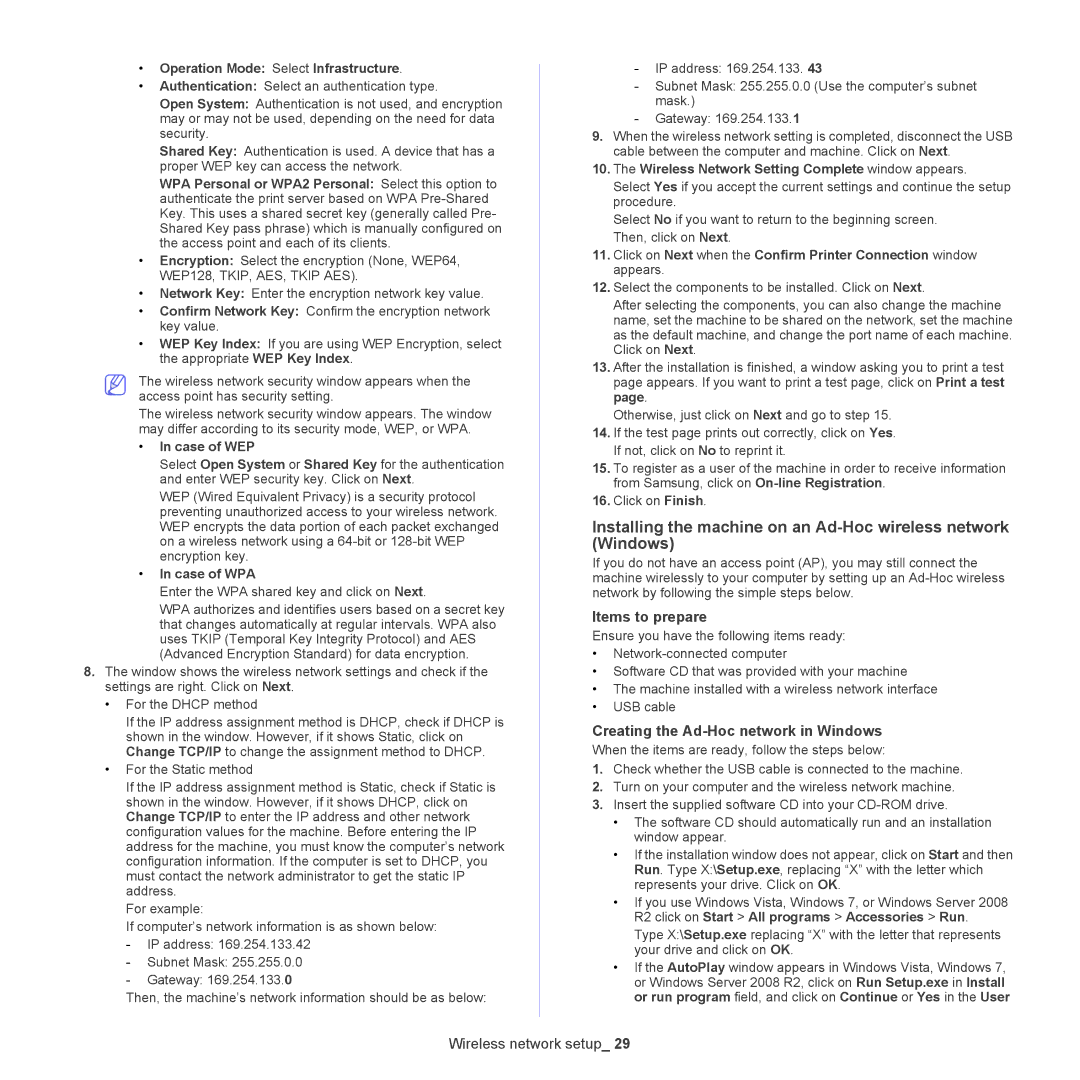
•Operation Mode: Select Infrastructure.
•Authentication: Select an authentication type.
Open System: Authentication is not used, and encryption may or may not be used, depending on the need for data security.
Shared Key: Authentication is used. A device that has a proper WEP key can access the network.
WPA Personal or WPA2 Personal: Select this option to authenticate the print server based on WPA
•Encryption: Select the encryption (None, WEP64, WEP128, TKIP, AES, TKIP AES).
•Network Key: Enter the encryption network key value.
•Confirm Network Key: Confirm the encryption network key value.
•WEP Key Index: If you are using WEP Encryption, select the appropriate WEP Key Index.
The wireless network security window appears when the access point has security setting.
The wireless network security window appears. The window may differ according to its security mode, WEP, or WPA.
•In case of WEP
Select Open System or Shared Key for the authentication and enter WEP security key. Click on Next.
WEP (Wired Equivalent Privacy) is a security protocol preventing unauthorized access to your wireless network. WEP encrypts the data portion of each packet exchanged on a wireless network using a
•In case of WPA
Enter the WPA shared key and click on Next.
WPA authorizes and identifies users based on a secret key that changes automatically at regular intervals. WPA also uses TKIP (Temporal Key Integrity Protocol) and AES (Advanced Encryption Standard) for data encryption.
8.The window shows the wireless network settings and check if the settings are right. Click on Next.
•For the DHCP method
If the IP address assignment method is DHCP, check if DHCP is shown in the window. However, if it shows Static, click on Change TCP/IP to change the assignment method to DHCP.
•For the Static method
If the IP address assignment method is Static, check if Static is shown in the window. However, if it shows DHCP, click on Change TCP/IP to enter the IP address and other network configuration values for the machine. Before entering the IP address for the machine, you must know the computer’s network configuration information. If the computer is set to DHCP, you must contact the network administrator to get the static IP address.
For example:
If computer’s network information is as shown below:
-IP address: 169.254.133.42
-Subnet Mask: 255.255.0.0
-Gateway: 169.254.133.0
Then, the machine’s network information should be as below:
-IP address: 169.254.133. 43
-Subnet Mask: 255.255.0.0 (Use the computer’s subnet mask.)
-Gateway: 169.254.133.1
9.When the wireless network setting is completed, disconnect the USB cable between the computer and machine. Click on Next.
10.The Wireless Network Setting Complete window appears.
Select Yes if you accept the current settings and continue the setup procedure.
Select No if you want to return to the beginning screen. Then, click on Next.
11.Click on Next when the Confirm Printer Connection window appears.
12.Select the components to be installed. Click on Next.
After selecting the components, you can also change the machine name, set the machine to be shared on the network, set the machine as the default machine, and change the port name of each machine. Click on Next.
13.After the installation is finished, a window asking you to print a test page appears. If you want to print a test page, click on Print a test page.
Otherwise, just click on Next and go to step 15.
14.If the test page prints out correctly, click on Yes. If not, click on No to reprint it.
15.To register as a user of the machine in order to receive information from Samsung, click on
16.Click on Finish.
Installing the machine on an
If you do not have an access point (AP), you may still connect the machine wirelessly to your computer by setting up an
Items to prepare
Ensure you have the following items ready:
•
•Software CD that was provided with your machine
•The machine installed with a wireless network interface
•USB cable
Creating the Ad-Hoc network in Windows
When the items are ready, follow the steps below:
1.Check whether the USB cable is connected to the machine.
2.Turn on your computer and the wireless network machine.
3.Insert the supplied software CD into your
•The software CD should automatically run and an installation window appear.
•If the installation window does not appear, click on Start and then Run. Type X:\Setup.exe, replacing “X” with the letter which represents your drive. Click on OK.
•If you use Windows Vista, Windows 7, or Windows Server 2008 R2 click on Start > All programs > Accessories > Run.
Type X:\Setup.exe replacing “X” with the letter that represents your drive and click on OK.
•If the AutoPlay window appears in Windows Vista, Windows 7, or Windows Server 2008 R2, click on Run Setup.exe in Install or run program field, and click on Continue or Yes in the User
Wireless network setup_ 29
